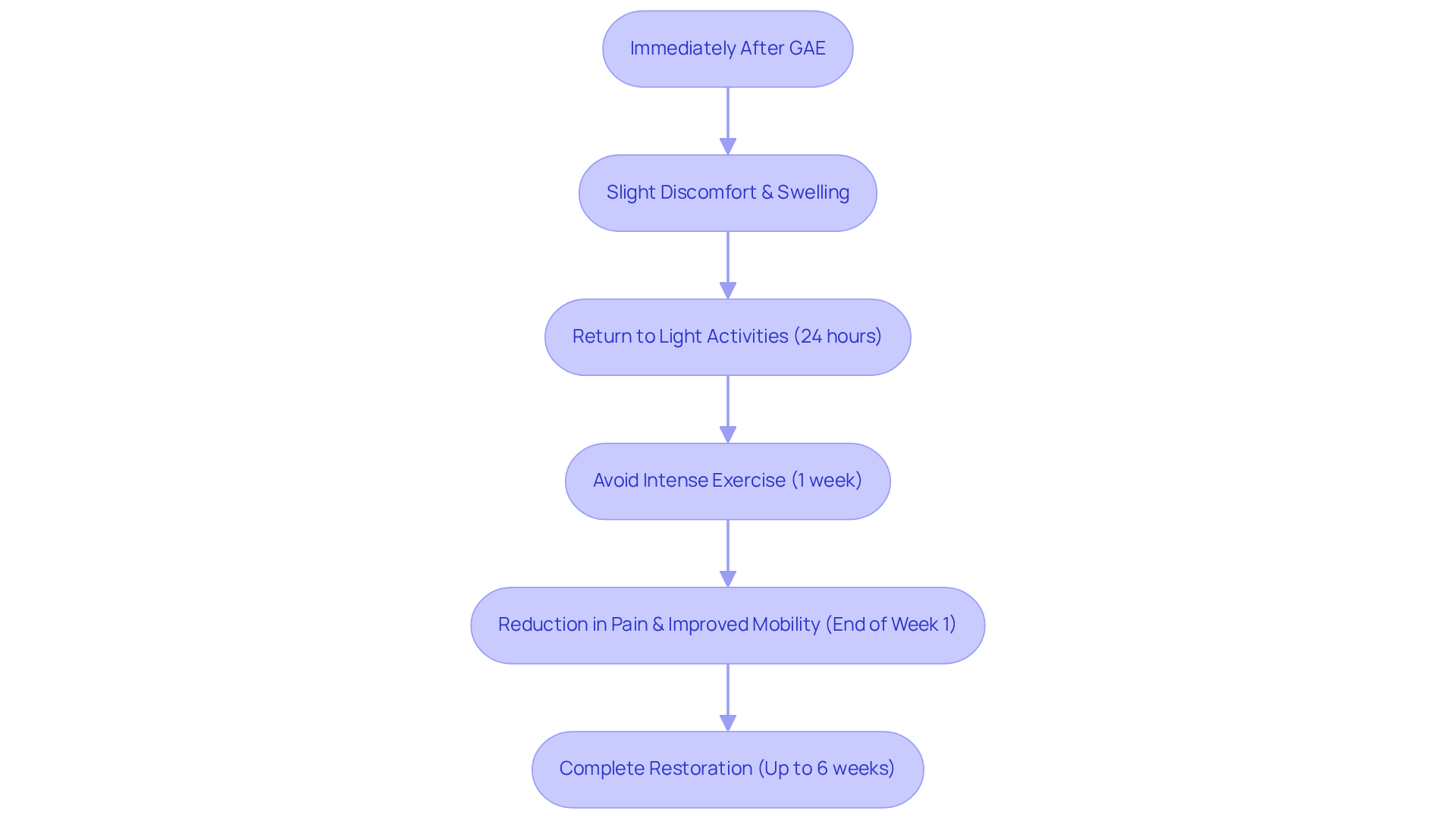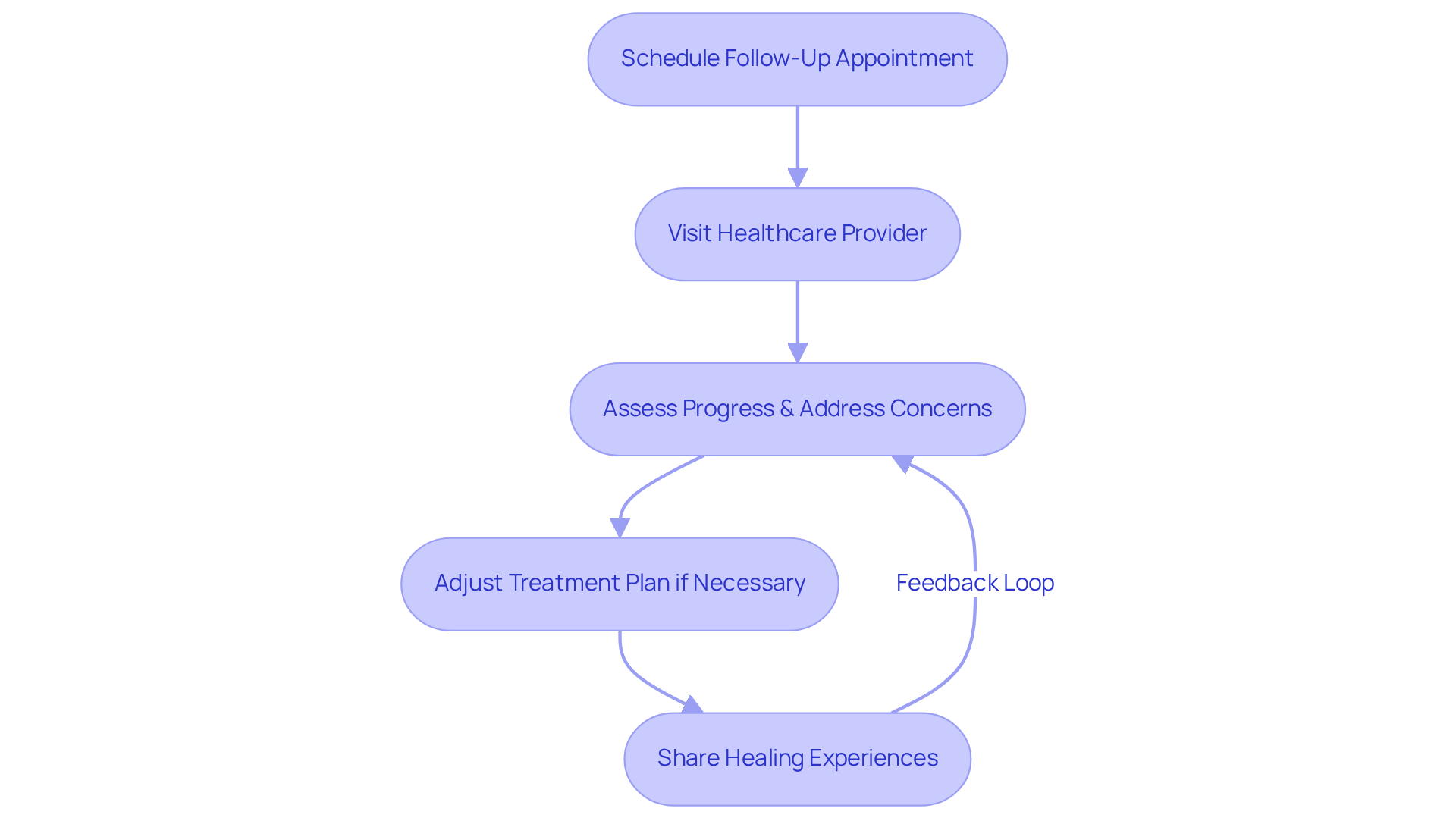


This article offers vital outpatient aftercare tips designed specifically for elderly patients recovering from Genicular Artery Embolization (GAE). It is essential to maintain a balanced diet, stay hydrated, engage in gentle physical activity, and attend follow-up appointments. These strategies not only enhance recovery outcomes but also significantly aid in healing and improving mobility.
As you navigate this recovery journey, you may have concerns about how to best support your health. Remember, adopting these practices can make a meaningful difference in your recovery. In addition to this, staying connected with your healthcare provider ensures that you receive the guidance and support you need.
Consider how a balanced diet can nourish your body and aid in your healing. Staying hydrated is equally important, as it helps maintain your energy levels and overall well-being. Furthermore, engaging in gentle physical activity can promote mobility and strength, allowing you to regain your independence.
It’s perfectly normal to feel anxious during this time, but rest assured that you are not alone. Many patients have found that following these aftercare tips has significantly improved their recovery experiences. We encourage you to reach out to your healthcare team if you have any questions or need further support. Your health and comfort are our top priorities.
Navigating the complexities of recovery after a medical procedure can be particularly daunting for elderly patients. This is especially true when it comes to innovative treatments like Genicular Artery Embolization (GAE). This minimally invasive procedure offers hope for those suffering from knee osteoarthritis. However, the journey doesn't end with the procedure itself.
Understanding essential aftercare strategies can significantly enhance recovery outcomes. By focusing on these strategies, we can help ensure that patients regain their mobility and comfort. What are the key practices that can truly make a difference in the healing process? How can caregivers provide the necessary support during this critical time?
In addition to this, caregivers play a vital role in fostering a supportive environment. With the right guidance and care, patients can feel more at ease, knowing they are not alone on this journey. Together, we can make a meaningful impact on their recovery.
Are you struggling with discomfort from knee osteoarthritis? Genicular Artery Embolization (GAE) might offer you a gentle solution. This minimally invasive technique is designed to alleviate the pain associated with this condition by specifically targeting the genicular arteries.
During the procedure, a small catheter is carefully inserted through a tiny incision, usually in the groin, and navigated to the genicular arteries. Once in place, tiny particles are introduced to block blood flow to the affected area. This action helps reduce inflammation and, ultimately, discomfort. It's comforting to know that this outpatient procedure, which is part of GAE outpatient aftercare, is performed under local anesthesia, allowing for a quicker recovery compared to traditional surgical methods.
Understanding this innovative approach can empower you to manage your discomfort effectively. Many patients have found that after the procedure, they experience not only relief but also an enhanced ability to move freely. If you have any questions or concerns, reaching out for support is a great next step. You deserve to feel comfortable and regain your mobility.

After undergoing GAE, you might be wondering about the recovery timeline, which typically spans several days to weeks. Initially, it’s common to experience slight discomfort and swelling, but rest assured, this can be managed with prescribed relief. In just 24 hours, many individuals find they can return to light activities. However, it's wise to avoid intense exercise for at least a week to allow your body to heal properly.
By the end of the first week, many report a noticeable reduction in pain and an improvement in mobility, which can be quite encouraging. Complete restoration, along with the full benefits of the procedure, may take up to six weeks. During this time, regular check-ins with your healthcare provider are essential. They are there to monitor your progress and address any concerns you may have. Remember, you are not alone on this journey; support is available every step of the way.

To enhance your healing journey after GAE, it's important to embrace several effective GAE outpatient aftercare strategies that can truly make a difference. Maintaining a balanced diet, rich in anti-inflammatory foods, can significantly support your recovery. Have you considered how hydration plays a vital role? Aim to drink plenty of fluids, as this is essential for your healing process.
Gentle physical activity, such as walking or stretching, can promote circulation and prevent stiffness. However, it's crucial to approach this with care. Following your prescribed medications and attending all follow-up appointments will help monitor your progress and ensure you’re on the right track. Additionally, engaging in physical therapy may be beneficial for regaining strength and mobility.
Remember, caregivers are here to support you every step of the way. They play an essential role in encouraging and motivating you throughout your healing journey, ensuring you feel valued and understood. Together, you can navigate this process with confidence and compassion.

Follow-up care plays a vital role in your healing journey after GAE. It's essential to schedule your GAE outpatient aftercare follow-up appointments as advised by your healthcare provider, typically within one to two weeks after the procedure. During these visits, your healthcare team will assess your progress, address any concerns you might have, and adjust your treatment plan if necessary.
Have you felt any changes in your symptoms or pain levels? It’s important to share your healing experiences openly. This proactive approach not only aids in managing your recovery effectively but also nurtures a trusting relationship between you and your healthcare team. By working together, we can strive for the best possible health outcomes for you.
Remember, your voice matters in this process. Don't hesitate to express your feelings and any new experiences during your follow-up visits. Together, we can ensure that your healing journey is supported and that you feel valued every step of the way.

Embracing the journey of recovery following Genicular Artery Embolization (GAE) is essential for elderly patients seeking relief from knee osteoarthritis. Understanding this procedure and the recovery timeline can feel overwhelming, but it’s important to know that you are not alone. This article highlights effective aftercare strategies and the significance of follow-up care, all of which play a pivotal role in ensuring a smooth healing process and enhancing your overall well-being.
Key insights reveal the minimally invasive nature of GAE, allowing for a quicker return to daily activities. It’s vital to adhere to prescribed aftercare practices, such as maintaining a balanced diet and engaging in gentle physical activity. Have you considered how these small steps can significantly impact your recovery? The critical role of follow-up appointments in monitoring your progress cannot be overstated. By actively participating in your recovery and maintaining open communication with your healthcare providers, you can optimize your healing experience.
Ultimately, the path to recovery after GAE is a collaborative effort involving you, your caregivers, and healthcare professionals. By prioritizing aftercare and follow-up strategies, you can regain mobility and improve your quality of life. Taking these steps not only fosters a sense of empowerment but also reinforces the notion that effective recovery is within reach. Remember, your journey is supported every step of the way.
What is Genicular Artery Embolization (GAE)?
Genicular Artery Embolization (GAE) is a minimally invasive procedure designed to alleviate pain associated with knee osteoarthritis by targeting the genicular arteries.
How is the GAE procedure performed?
The procedure involves inserting a small catheter through a tiny incision, usually in the groin, and navigating it to the genicular arteries. Tiny particles are then introduced to block blood flow to the affected area, which helps reduce inflammation and discomfort.
What type of anesthesia is used during the GAE procedure?
The GAE procedure is performed under local anesthesia, which contributes to a quicker recovery compared to traditional surgical methods.
Is GAE an outpatient procedure?
Yes, GAE is an outpatient procedure, meaning patients can go home the same day after the treatment.
What are the expected outcomes after undergoing GAE?
Many patients experience relief from pain and an enhanced ability to move freely after the procedure.
Who should consider undergoing Genicular Artery Embolization?
Individuals struggling with discomfort from knee osteoarthritis may consider GAE as a treatment option to manage their pain effectively.